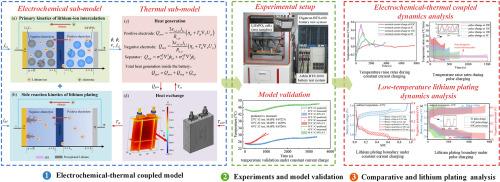高倍率充电条件下锂离子电池电化学-热耦合建模及镀锂分析
IF 5
2区 工程技术
Q1 ENGINEERING, MECHANICAL
International Journal of Thermal Sciences
Pub Date : 2025-09-24
DOI:10.1016/j.ijthermalsci.2025.110337
引用次数: 0
摘要
随着快速充电需求的不断增长,需要对锂离子电池在高倍率条件下的性能有更深入的了解,这将导致显著的电化学-热耦合,并带来热安全风险。此外,低温充电促进锂电镀,增加内部短路的风险。本研究提出了一个电化学-热耦合模型来分析电池在高倍率充电下的行为,并额外关注低温效应和锂电镀。该模型集成了电化学动力学,包括锂离子嵌入和电镀,以及描述热量产生和耗散的热子模型。通过不同速率和温度下的充放电实验验证了该模型准确预测电瞬变和热瞬变的能力。对比分析表明,脉冲充电优于恒流充电,可实现20C的充电速率,充电时间缩短至382 s。低温充电实验表明,脉冲电流充电不仅能加快充电速度,还能有效防止镀锂。这些发现为优化热管理和改进电池策略提供了有价值的见解,突出了该模型在快速充电应用中提高锂离子电池安全性和效率的潜力。本文章由计算机程序翻译,如有差异,请以英文原文为准。

Electrochemical-thermal coupled modeling and lithium plating analysis of lithium-ion batteries under high-rate charging
The growing demand for fast charging necessitates a deeper understanding of lithium-ion battery performance under high-rate conditions, which induce significant electrochemical-thermal coupling and pose thermal safety risks. Additionally, low-temperature charging promotes lithium plating, increasing the risk of internal short circuits. This study presents an electrochemical-thermal coupled model to analyze battery behavior under high-rate charging, with an additional focus on low-temperature effects and lithium plating. The model integrates electrochemical kinetics, including lithium-ion intercalation and plating, with a thermal sub-model that describes heat generation and dissipation. Validation through charge-discharge experiments at varying rates and temperatures demonstrates the model's ability to accurately predict both electrical and thermal transients. Comparative analysis shows that pulse charging outperforms constant current charging, achieving a 20C charge rate and reducing charging time to 382 s. Furthermore, low-temperature charging experiments indicate that pulse current charging not only accelerates charging speed but also effectively prevents lithium plating. These findings provide valuable insights into optimizing thermal management and improving battery strategies, highlighting the model's potential for enhancing the safety and efficiency of lithium-ion batteries in fast-charging applications.
求助全文
通过发布文献求助,成功后即可免费获取论文全文。
去求助
来源期刊

International Journal of Thermal Sciences
工程技术-工程:机械
CiteScore
8.10
自引率
11.10%
发文量
531
审稿时长
55 days
期刊介绍:
The International Journal of Thermal Sciences is a journal devoted to the publication of fundamental studies on the physics of transfer processes in general, with an emphasis on thermal aspects and also applied research on various processes, energy systems and the environment. Articles are published in English and French, and are subject to peer review.
The fundamental subjects considered within the scope of the journal are:
* Heat and relevant mass transfer at all scales (nano, micro and macro) and in all types of material (heterogeneous, composites, biological,...) and fluid flow
* Forced, natural or mixed convection in reactive or non-reactive media
* Single or multi–phase fluid flow with or without phase change
* Near–and far–field radiative heat transfer
* Combined modes of heat transfer in complex systems (for example, plasmas, biological, geological,...)
* Multiscale modelling
The applied research topics include:
* Heat exchangers, heat pipes, cooling processes
* Transport phenomena taking place in industrial processes (chemical, food and agricultural, metallurgical, space and aeronautical, automobile industries)
* Nano–and micro–technology for energy, space, biosystems and devices
* Heat transport analysis in advanced systems
* Impact of energy–related processes on environment, and emerging energy systems
The study of thermophysical properties of materials and fluids, thermal measurement techniques, inverse methods, and the developments of experimental methods are within the scope of the International Journal of Thermal Sciences which also covers the modelling, and numerical methods applied to thermal transfer.
 求助内容:
求助内容: 应助结果提醒方式:
应助结果提醒方式:


